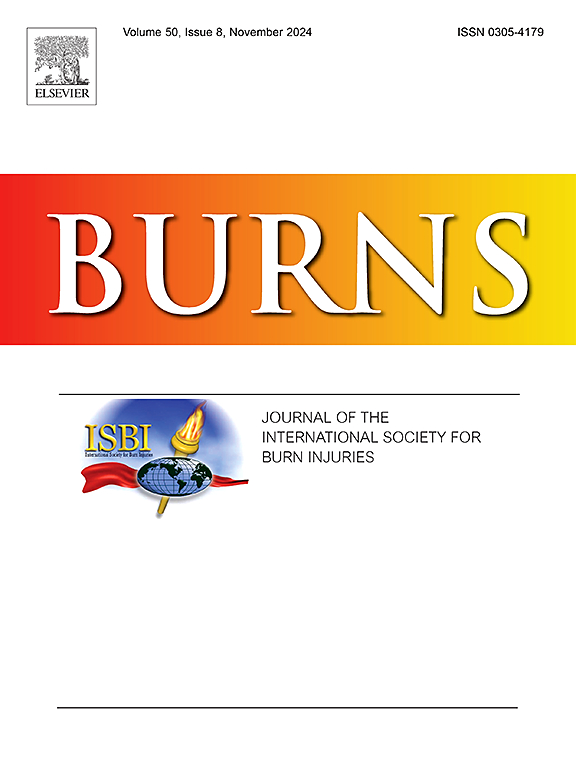利用双向孟德尔随机化研究皮肤微生物群与增生性瘢痕之间的因果关系。
IF 3.2
3区 医学
Q2 CRITICAL CARE MEDICINE
引用次数: 0
摘要
背景:增生性瘢痕(HS)被认为是真皮的一种病理性纤维增生性疾病,由过度的结缔组织生长引起。由于社会和功能问题,HS显著影响患者的生活质量。尽管有多种治疗方法,但治疗效果仍然有限,需要进一步探索其潜在因素和机制。目的:本研究旨在采用双向孟德尔随机化(MR)方法确定皮肤微生物群与HS之间的因果关系。方法:我们利用来自PopGen队列和FinnGen数据库的全基因组关联研究(GWAS)数据。与皮肤微生物群相关的独立单核苷酸多态性(snp)被确定为选择用于双样本MR分析的工具变量(IVs)。主要分析方法包括方差反加权(IVW)、MR-Egger、简单中位数、简单模式和加权模式,其中MR-Egger截距检验和Cochrane’s Q检验用于检测潜在的水平多效性和异质性。结果:两样本MR分析确定了特定皮肤微生物群特征与HS之间的显著因果关系。值得注意的是,湿润皮肤上的Enhydrobacter, Micrococcus和Acinetobacter表现出对HS的保护作用,而干燥皮肤上的Finegoldia和Lactobacillales则与HS的风险增加有关。敏感性分析证实了这些结果的强度,显示没有显著的水平多效性或异质性。结论:我们的研究揭示了某些皮肤微生物群与HS之间的单向因果关系,表明调节皮肤微生物群可能是一种新的治疗HS的方法。这些结果强调了考虑皮肤微生物群在HS发病和治疗中的重要性。本文章由计算机程序翻译,如有差异,请以英文原文为准。
Investigating the causal relationship between skin microbiota and hypertrophic scar using bidirectional mendelian randomization
Background
Hypertrophic scar (HS) is acknowledged as a pathological fibro-proliferative disease of the dermis, resulting from excessive connective tissue growth. HS significantly impacts patient quality of life due to both social and functional issues. Despite various treatments, therapeutic effectiveness remains limited, necessitating further exploration of underlying factors and mechanisms.
Objective
The current study was designed to determine the causal relationship between skin microbiota and HS employing a bidirectional Mendelian randomization (MR) approach.
Methods
We utilized genome-wide association study (GWAS) data from the PopGen cohort and the FinnGen database. Independent single nucleotide polymorphisms (SNPs) linked to the skin microbiota were identified as instrumental variables (IVs) chosen for the two-sample MR analysis. Key analytical approaches included inverse variance weighting (IVW), MR-Egger, simple median, simple mode, and weighted mode, with MR-Egger intercept test and Cochrane’s Q test used to detect potential horizontal pleiotropy and heterogeneity.
Results
The two-sample MR analysis identified significant causal relationships between specific skin microbiota features and HS. Notably, Enhydrobacter, Micrococcus, and Acinetobacter on moist skin exhibited protective effects against HS, whereas Finegoldia and Lactobacillales on dry skin were linked to an increased risk of HS. Sensitivity analyses verified the strength of these results, revealing no notable horizontal pleiotropy or heterogeneity.
Conclusion
Our research reveals a unidirectional causal relationship between certain skin microbiota and HS, suggesting that modulation of skin microbiota could be a novel therapeutic approach for HS management. These results emphasize the significance of considering skin microbiota in the pathogenesis and treatment of HS.
求助全文
通过发布文献求助,成功后即可免费获取论文全文。
去求助
来源期刊

Burns
医学-皮肤病学
CiteScore
4.50
自引率
18.50%
发文量
304
审稿时长
72 days
期刊介绍:
Burns aims to foster the exchange of information among all engaged in preventing and treating the effects of burns. The journal focuses on clinical, scientific and social aspects of these injuries and covers the prevention of the injury, the epidemiology of such injuries and all aspects of treatment including development of new techniques and technologies and verification of existing ones. Regular features include clinical and scientific papers, state of the art reviews and descriptions of burn-care in practice.
Topics covered by Burns include: the effects of smoke on man and animals, their tissues and cells; the responses to and treatment of patients and animals with chemical injuries to the skin; the biological and clinical effects of cold injuries; surgical techniques which are, or may be relevant to the treatment of burned patients during the acute or reconstructive phase following injury; well controlled laboratory studies of the effectiveness of anti-microbial agents on infection and new materials on scarring and healing; inflammatory responses to injury, effectiveness of related agents and other compounds used to modify the physiological and cellular responses to the injury; experimental studies of burns and the outcome of burn wound healing; regenerative medicine concerning the skin.
 求助内容:
求助内容: 应助结果提醒方式:
应助结果提醒方式:


